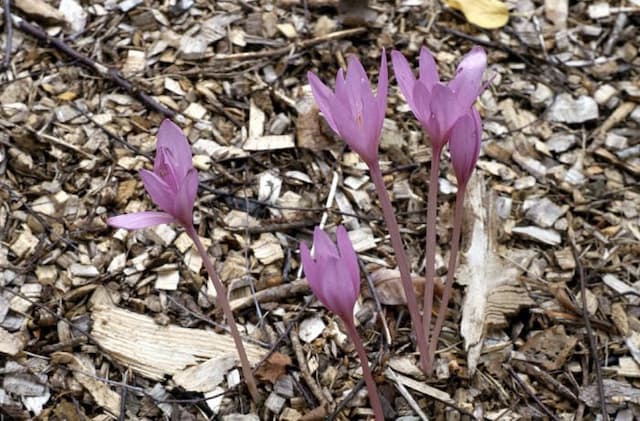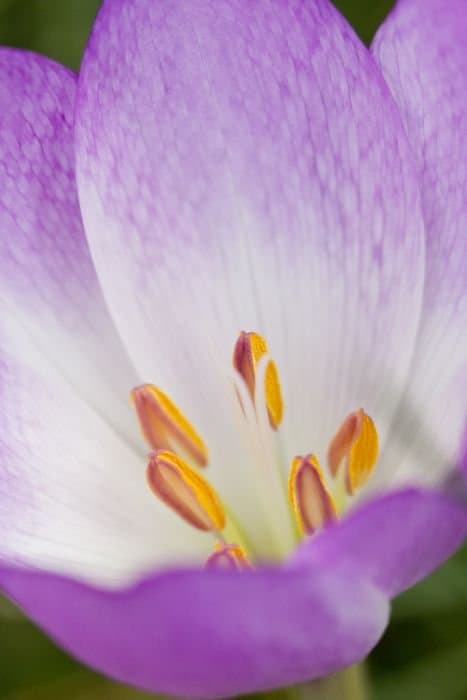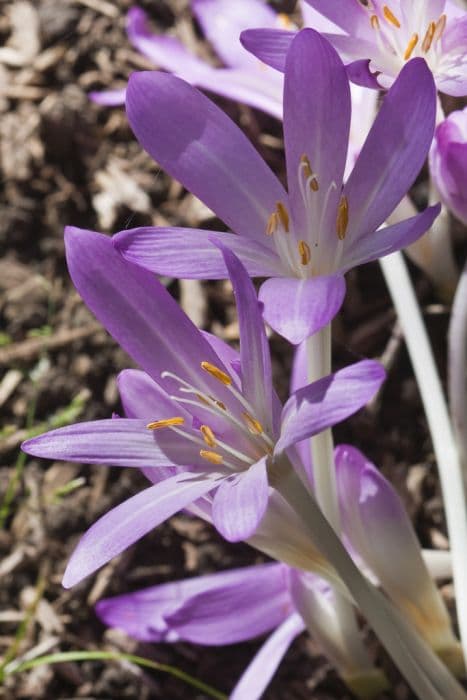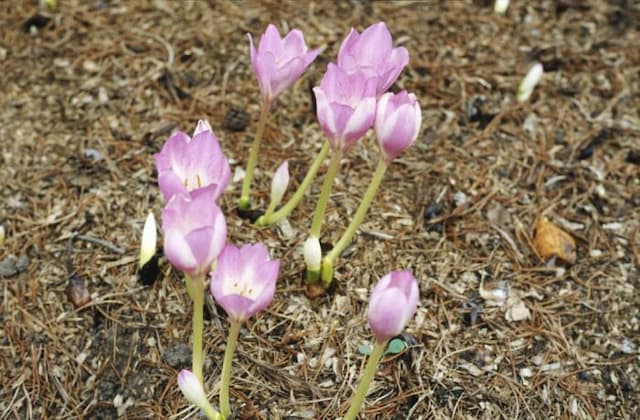Autumn Crocus Colchicum autumnale

ABOUT
The plant commonly known as autumn crocus features striking, funnel-shaped flowers which sprout directly from the ground, seemingly emerging from nowhere since they lack any visible stem above the soil level. Its beauty is distinctive with petals that range in color from a light lilac to a deep mauve or sometimes pure white, with six petals unfurling to reveal a star-like formation when viewed from above. At the center of each flower, striking, prominent stamens masquerade as a delicate centerpiece. This plant also produces long, slender leaves that often emerge after the flowering season, which is typically late summer or autumn. These leaves are a glossy green and have an elongated shape with a pointed tip, forming a lush clump that may sometimes be mistaken for an unrelated green plant once the flowers have withered. The overall impression of the autumn crocus is one of a delicate yet robust flowering plant that brings a splash of color to the end-of-season garden.
About this plant
 Names
NamesFamily
Colchicaceae
Synonyms
Autumn Crocus, Meadow Saffron, Naked Ladies
Common names
Colchicum commune, Colchicum veronense, Colchicum vulgare.
 Toxicity
ToxicityTo humans
The plant Colchicum autumnale, commonly known as autumn crocus, is highly toxic to humans. It contains compounds such as colchicine and colchicoside, which can cause serious health issues if ingested. Symptoms of autumn crocus poisoning include gastrointestinal distress such as nausea, vomiting, and diarrhea, which can lead to severe dehydration and electrolyte imbalances. It may also cause multi-organ failure, respiratory depression, and can be fatal if left untreated. The entire plant, including the bulbs, leaves, and seeds, is poisonous.
To pets
Autumn crocus (Colchicum autumnale) is also toxic to pets, including dogs, cats, and horses. If a pet ingests any part of the plant, it can suffer from colchicine toxicity. Symptoms of poisoning in pets may include drooling, vomiting, diarrhea, abdominal pain, severe gastrointestinal upset, and potentially multi-organ failure or central nervous system effects such as seizures. Ingestion of autumn crocus can be life-threatening and requires immediate veterinary attention.
 Characteristics
CharacteristicsLife cycle
Perennials
Foliage type
Deciduous
Color of leaves
Green
Flower color
Pink
Height
6 inches (15 cm)
Spread
3 inches (7.5 cm)
Plant type
Bulb
Hardiness zones
4
Native area
Europe
Benefits
 General Benefits
General Benefits- Ease of cultivation: Colchicum autumnale is relatively easy to grow and maintain in a variety of garden settings.
- Aesthetic appeal: With its vibrant pink and purple flowers, it adds a splash of color to autumn gardens.
- Autumn blooming: It provides a unique floral display at a time when many other plants have ceased to bloom.
- Naturalizing: This plant can spread and naturalize in an area, filling out the space and creating a more densely planted environment over time.
- Drought tolerance: Once established, it is quite tolerant of dry conditions, making it suitable for regions with lower rainfall.
- Deer and rabbit resistance: It is generally resistant to browsing by deer and rabbits, which can help to keep the garden intact.
- Pollinator attraction: Bees and other pollinators are attracted to its flowers, which can help to encourage a healthy ecosystem.
 Medical Properties
Medical Properties- Alkaloid colchicine content: Used to treat gout and familial Mediterranean fever by reducing inflammation and decreasing uric acid.
- Anti-inflammatory properties: May help alleviate swelling and pain associated with inflammatory diseases.
- Mitotic inhibitor: Colchicine is also used in the treatment of certain cancers due to its ability to inhibit cell division.
 Air-purifying Qualities
Air-purifying QualitiesThis plant is not specifically known for air purifying qualities.
 Other Uses
Other Uses- Colchicum autumnale, commonly known as autumn crocus, can be used as a natural dye source, providing colors like yellow, green, and brown when the corms are processed with alum as a mordant.
- The pollen from the autumn crocus has been historically used for cosmetic purposes, such as making eyebrow powder and a blush for the cheeks.
- Gardeners utilize the autumn crocus for naturalizing in grassy areas, as they bloom in the fall, they can provide a surprise pop of color after most other flowers have faded.
- The large, showy flowers of the autumn crocus can be used in cut flower arrangements, although they must be handled carefully due to their toxic nature.
- Photographers and artists often use the striking appearance of autumn crocus for creative inspiration, featuring them in photographs, drawings, and paintings.
- In some traditional ceremonies, autumn crocus has been used decoratively to adorn altars and as part of floral displays due to their bright, attractive flowers.
- Autumn crocuses are sometimes used in educational settings, such as biology classes, to study plant growth patterns and flower development.
- Some cultures have used the autumn crocus in small quantities as a rodent repellent, although this usage is risky due to the plant's toxicity and is not widely recommended.
- Eco-friendly burial options sometimes include the autumn crocus, as it can be planted on graves to symbolize a respect for nature and the cycle of life.
- Autumn crocus petals have been used in the past for bookmaking and papermaking, providing a unique texture and design to handcrafted paper products.
Interesting Facts
 Feng Shui
Feng ShuiThe Autumn crocus is not used in Feng Shui practice.
 Zodiac Sign Compitability
Zodiac Sign CompitabilityThe Autumn crocus is not used in astrology practice.
 Plant Symbolism
Plant Symbolism- Beauty: Colchicum autumnale, commonly known as autumn crocus, often symbolizes beauty due to its delicate and vibrant purple flowers that bloom in the fall.
- Resilience: As this plant blooms in autumn, often pushing through the fallen leaves, it represents resilience and an ability to thrive in adverse situations.
- Transition: The autumn crocus is a harbinger of the changing seasons, blooming in late summer or early fall, and thus symbolizes transition and change.
- Surprise: Since the autumn crocus unexpectedly flowers in the fall, when most other plants are preparing to enter dormancy, it embodies the notion of an unexpected or surprise development.
- Caution: Autumn crocus is known to be highly toxic, and therefore, it often symbolizes caution or danger in the context of its beautiful appearance hiding a potential threat.
 Water
WaterAutumn crocus requires moderate watering during the active growing season, usually in the fall, and should be watered when the top inch of soil feels dry. Provide about 1 to 2 gallons of water per square yard of soil every week during this period. It is essential not to overwater, as the bulbs are prone to rot in excessively moist conditions. During the summer, when the plant is dormant, watering should be reduced significantly, only to prevent the soil from completely drying out. Ensure water is applied directly to the soil to avoid wetting the foliage, which could encourage fungal diseases.
 Light
LightThe autumn crocus thrives best in full sun to partial shade conditions. An ideal spot would be one that receives morning sunlight and is shaded in the afternoon or a dappled shade area under trees. These plants can handle some direct sunlight but prefer to be protected during the hottest part of the day to prevent scorching of the leaves.
 Temperature
TemperatureAutumn crocus prefer a temperate range and can survive a minimum temperature of around -10°F once established. They thrive best when the temperature is between 50°F and 70°F. The bulbs require a period of winter chilling to promote blooming, so cold winter temperatures are beneficial as long as the bulbs are planted several inches deep to prevent freeze damage.
 Pruning
PruningPruning the autumn crocus is not required for flowering, but spent flowers should be removed to maintain plant appearance. Leaf yellowing naturally occurs as the plant goes dormant; at this time, remove the yellowed leaves to keep the garden tidy. The best time to remove fading foliage is in late spring when it has fully yellowed and easily pulls away from the bulb, indicating it is no longer feeding the plant.
 Cleaning
CleaningAs needed
 Soil
SoilAutumn Crocus thrives in well-draining, compost-rich soil with a neutral to slightly alkaline pH, ideally between 6.0 and 7.5. Mix loamy garden soil with compost and some sand or perlite to improve drainage.
 Repotting
RepottingAutumn Crocus bulbs should be repotted every few years or as they multiply and outgrow their current space. It's best to repot after the foliage dies back in late spring or early summer.
 Humidity & Misting
Humidity & MistingAutumn Crocus prefers moderate humidity levels. While specific humidity requirements are not stringent, avoiding excessively dry air is advisable. Average room humidity is typically sufficient for this plant.
 Suitable locations
Suitable locationsIndoor
Ensure bright indirect light, cooler temperatures, and well-draining soil for indoor Autumn Crocus.
Outdoor
Plant Autumn Crocus bulbs in fall, in well-drained soil, partial shade to full sun.
Hardiness zone
4-9 USDA
 Life cycle
Life cycleColchicum autumnale, commonly known as autumn crocus, begins its life cycle when the seeds germinate in the spring, developing into small corms that remain dormant through the summer. In the fall, the corms produce large, showy purple flowers without any foliage, which is a unique characteristic termed "naked blooming." After flowering, the foliage emerges, generally in the form of long, strappy leaves that photosynthesize throughout the winter to nourish the corm. As spring arrives, the foliage dies back, and the corm enters a summer dormancy period where it remains underground in a state of rest. The autumn crocus' corm grows larger each year, and over time, it can produce offsets, leading to a clonal colony. After several years, when conditions are favorable, the mature corms will repeat this growth cycle, continuing to flower annually in the autumn.
 Propogation
PropogationPropogation time
Late summer to early fall
The most popular method of propagation for Colchicum autumnale, commonly known as autumn crocus, is by dividing the corms. The best time to propagate the autumn crocus by division is in the summer after the leaves have died back. Gardeners should carefully dig up the corms and gently separate any offsets from the parent corm. Ideally, these offsets should be about the size of a large marble, or approximately 0.75 to 1 inch (about 2 to 2.5 cm) in diameter. These new corms can then be replanted immediately at a depth of around 3 inches (about 7.5 cm) with spacing of 4 to 6 inches (about 10 to 15 cm) apart in well-draining soil. Care should be taken not to damage the base of the corms, as this is where the roots develop. In a favorable environment, these corms will develop into flowering plants by the following fall season.








